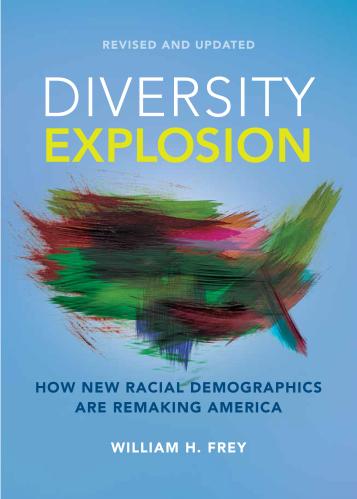Trend reflects restrictive immigration policies and historic low in US population growth
Newly released Census Bureau statistics reveal that from 2010 to 2020, the nation’s foreign-born population will experience the smallest growth for any decade since the 1970s. This American Community Survey data through year 2019 shows that even before COVID-19 hit, foreign-born gains plummeted between the first and third years of the Trump presidency, contributing to a growth slowdown for the entire decade. But at the same time, the data reveals that foreign-born population changes during the 2010s have countered the Trump administration’s immigration stereotype, drawing immigrants more broadly from Asia rather than Latin America, as well as favoring those with college, professional, and graduate educations.
The decade has also shown a dispersion of foreign-born persons to less urbanized states in the “middle” of the country, especially those that Trump carried in the 2016 presidential election. All of this makes clear that foreign-born population changes in the 2010s differ sharply from those during the nation’s higher-immigration years. This, along with increased immigration restrictions instituted by the administration since the onset of COVID-19, could likely lead to a very different immigration scenario for the 2020s with diminished overall population growth.
Putting the brakes on foreign-born growth
For two years straight, the U.S. saw an uncommonly small increase in its foreign-born population. In each year (2017 to 2018 and 2018 to 2019), it grew by barely more than 200,000—well below annual gains earlier in the decade, which ranged between 400,000 and 1 million. Changes in the country’s foreign-born population result from immigration to the U.S., emigration from the U.S., and deaths of foreign-born residents. Migration flows—both in and out—account for most of the changes observed here.

The new Census Bureau statistics show that the foreign-born population has gained just 4.9 million people during the 2010 to 2019 period. This is well below the 5.6 million, 11.3 million, and 8.8 million gained during the 1980s, 1990s, and 2000s, respectively. These were the peak immigration decades after the enactment of the Immigration and Nationality Act of 1965, which abolished restrictive national immigration quotas. Given the recent COVID-19 restrictions on immigration enacted by the Trump administration, it is unlikely that the 2010 to 2020 decade will register a higher foreign-born gain than observed in the previous three (Download Table A).
The recent slowdown in foreign-born growth is largely attributable to negative growth of noncitizens—a category that includes both legal and undocumented immigrants. The 2019 noncitizen foreign-born population of 21.7 million comprises nearly half of the 44.9 million foreign-born population. (It is estimated that 10.5 million noncitizen foreign-born are undocumented.) In fact, it was only the noncitizen population which registered losses: a drop of 478,000 and 349,000 in the last two years. Meanwhile the naturalized citizen foreign-born population increased by 681,000 from 2017 to 2018 and 553,000 from 2018 to 2019. Prior to these years, there were some losses in the noncitizen population, but the magnitude of these losses between 2017 and 2019 dwarfed those observed earlier (Download Table B).
It is not possible to distinguish between legal noncitizen residents and undocumented residents in census statistics. However, it is clear that the Trump administration’s anti-immigrant rhetoric and actions to reduce admission of refugees have contributed to fewer inflows and greater outflows of foreign-born residents who are not naturalized citizens.
The foreign-born population share remained constant for three straight years
Consistent with the recent growth slowdown, the foreign-born share of the U.S. population has remained constant at 13.7% for the last three years. While this is still a higher share than in any year since 1910, the 2010s will be the first decade since 1970 when that share does not rise by more than 1%.

In 1970, the nation’s foreign-born share fell to an all-time low of 4.7%. This occurred after four decades of foreign-born population loss—a result of restrictive immigration legislation in the 1920s, the Great Depression, and World War II. Rises occurred after the passage of the 1965 Immigration and Nationality Act, which opened up immigration from Latin America and Asia. As a result, the foreign-born population rose in subsequent decades, with the largest gains between 1980 and 2010. Even with the small rise in the size of the foreign-born population from 44.7 million in 2018 to 44.9 million in 2019, the latter year represents the largest number of foreign-born people in the nation’s history.
Countering immigration stereotypes
Some of the Trump administration’s rhetoric about immigration—underlying its efforts to build a wall along the Mexican border—sends the message that immigrants to the U.S. come largely from Latin America and, in particular, Mexico. The administration has also pushed a stereotype that immigrants—by and large—are low skilled and will drain government coffers for social services and support. But the actual numbers since 2010 tell a different story.
Looking at region of origin, the new Census Bureau data shows that, between 2010 and 2019, foreign-born persons with Asian origins increased by 2.8 million, compared with just 1.3 million from Latin America. Latin Americans still comprise the largest number of foreign-born Americans, at 22.5 million (compared with 14 million Asians). However, during the last decade, Asians represented the largest gains by far. Since 2010, India, China, and the Philippines were the nations that added the most to the U.S. foreign-born population: 907,000, 687,000, and 267,000, respectively. At the same time, there was a loss of 779,000 foreign-born residents from Mexico. These trends predated Trump’s presidency (Download Table C).

In terms of educational attainment, the greatest 2010 to 2019 growth was registered by foreign-born persons with bachelor’s degrees or professional and graduate degrees. When looking at the net gains of 2010 to 2019 foreign-born adults (age 25 and older), nearly two-thirds were college graduates, compared to one-third of the native-born population. This counters long-held stereotypes promoted by the Trump administration.
Although recent foreign-born growth is smaller than in recent decades, it reflects more of what I have called America’s “21st century immigration,” with greater representation from Asia and the more highly educated than in the past.
A dispersal to middle America
Another feature of immigration in the past decade is the dispersal of the foreign-born population to new places instead of the heavily urbanized and mostly coastal destinations of the past.
The latter areas are located in states where foreign born residents already constitute higher foreign-born shares of the population. Thirteen such states are classified in Map 1 as “high concentration”—states with foreign-born shares that are equal to or higher than the national share of 13.7%. Among these are the nation’s largest states, including California, Texas, Florida, New York, and Illinois.

However, in the past decade, greater foreign-born growth occurred in the 25 states classified as having “medium” immigrant concentration (between 5% and 13.6% foreign-born), as well as 13 states classified as having “low” concentration (less than 5% foreign-born). These states are located in broad stretches of the middle of the country, including much of the Midwest, South, and interior West.
As a group, both medium- and low-concentration states registered foreign-born growth exceeding 18% over the 2010 to 2019 period, compared to just 10.5% for the high-concentration states. And 29 of these medium- and low-concentration states showed growth rates faster than the national foreign-born growth rate of 12.5%. In Georgia, Kentucky, South Carolina, North Dakota, and South Dakota, the foreign-born population grew by more than 30% from 2010 to 2019. (Hover over states on the map to view foreign-born population sizes, shares of total population, and growth rates.)
States with low foreign-born concentrations are also more likely to have higher numbers of residents from Asian or other countries outside Latin America. This is the case for eight of the 13 low-concentration states, including Ohio, Missouri, and West Virginia, where Asia is the largest region of origin. Foreign-born adults are also more likely than native-born adults to hold college degrees in each of the 13 low-concentration states (Download Table D).

It is noteworthy that many of these “new destination” states for foreign-born are politically “red,” having voted for Trump over Hillary Clinton in 2016. For several years in the past decade, foreign-born gains in red states, as a group, exceeded those for blue states. This was especially the case over the past two years when, together, blue states registered foreign-born losses. This reflects substantial losses in California, New York, and Illinois. At the same time, all but six of the nation’s 30 red states saw foreign-born gains, led by Florida, Texas, North Carolina, and Arizona.
The end of high immigration?
The new Census Bureau data makes plain that foreign-born population changes in the 2010s differ sharply from the past. Largely due to the Trump administration’s restrictive immigration policies and anti-immigrant rhetoric, the late-decade immigration slowdown will lead to diminished decade-wide growth in the foreign-born population, with the lowest gains since the 1970s.
However, even though it was smaller than previous decades, the 2010s’ foreign-born growth reflects a “21st century” immigration pattern that emphasizes a broader array of countries of origin and immigrant skill levels. These patterns fly in the face of immigration stereotypes promoted by Trump and many other politicians. If continued, we can look to future immigration patterns that include people able to succeed in both low- and high-skilled jobs, and attract immigrants from a variety of nations.
Even with that shift, the Trump administration’s crackdown on immigration—taking the form of refugee limits, immigrant bans, public-charge regulations, and more—has sharply reduced the growth of our foreign-born population. This decline could become sustained as a result of even more severe limits imposed since COVID-19.
But from a demographic standpoint, immigration to the U.S. is more important than ever before. Last year, the nation’s total population growth was at a century-long low, and census projections show that a decline in immigration will lead to lower future growth, population aging, and, in the near term, a decline in our young labor force population. While the COVID-19 pandemic has brought many challenges in both the short and long term, let us hope that America’s high immigration era has not ended.







